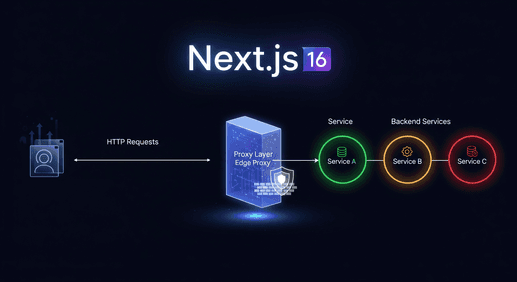Why Next.js is one of the best solutions for E-commerce?

In the constantly changing world of web development, e-commerce poses a unique set of challenges: complex product data, dynamic content, SEO demands, fast page loads, secure checkout flows, integration with multiple external systems and many, many more.
As developers, we’re constantly looking for tools that help us deliver all of this without compromising on performance or maintainability. Next.js delivers on all fronts — and then some more.
If you’re evaluating tech stacks for your next e-commerce project, here’s why Next.js deserves a spot at the top of your list.
⚡ 1. Performance by Design
E-commerce websites live and die by performance. According to Google, even a one-second delay in page load time can reduce conversions by up to 20%. Next.js addresses this head-on by giving you multiple rendering strategies:
- Static Site Generation (SSG)
- Server-Side Rendering (SSR)
- Client Side Rendering (CSR)
- Incremental Static Regeneration (ISR)
- Partial Prerendering (PPR, currently experimental)
This per-route rendering flexibility lets you optimize each part of your store — from blazing-fast landing pages to real-time personalized carts.
🔍 2. Built-in SEO Superpowers
Next.js delivers server-rendered HTML out of the box, making sure search engines like Google can immediately crawl meaningful content. For developers, this translates to:
- Full control of metadata with next/head, metadata object or even dynamic content with generateMetadata function
- SEO-friendly dynamic routing
- Easily integrated structured data for rich search snippets
When search engines properly index your category and product pages, you'll see a natural boost in organic traffic.
💾 3. Smart Data Caching and Request Management for Better Performance
In e-commerce, caching goes beyond storing page content. A major performance boost comes from efficient data fetching and preventing duplicate requests — crucial when handling large product catalogs, filtering systems, and personalized content.
Next.js provides complete control over data-layer caching, from server to edge computing. Better yet, it works out of the box without any custom configuration, thanks to its extended node fetch utility.
- Request Memoization - During server-side rendering, Next.js stores responses received via the fetch API. This means that regardless of where and how many times you request the same data in React Server Components (RSC), the actual request occurs only once.
- Data Cache - Need persistent data across multiple page renders, sessions, and users? Next.js provides this functionality out of the box by storing responses in deployed application memory in a controlled way.
- Full Route Cache - By caching renderable pages generated through SSG, ISR, or forced caching, Next.js can deliver content to end users at blazing speeds.
- Router Cache - Thanks to Next.js's ability to utilize both server and client environments, subsequent client-side navigations can be stored and reused within a single user session to display previously visible content immediately.
🌊 4. Streaming in Next.js: Faster Renders, Better UX, and SEO Gains
With the App Router and React Server Components, Next.js supports HTTP streaming, which allows the server to send HTML to the browser incrementally. Instead of waiting for the entire page to generate, content appears as soon as each part of the UI is ready.
This approach delivers significant performance and user experience benefits:
- Time to First Byte (TTFB): The server begins sending content instantly, reducing initial load time.
- Largest Contentful Paint (LCP): Essential elements like product titles, images, and prices appear early, with secondary components streaming in afterward.
- Perceived performance: Users see content faster, creating a more responsive experience.
On the SEO side, streaming offers two key advantages:
- Search engine bots can begin parsing HTML immediately through the open connection, continuously receiving the page's complete structure.
- The streamed content remains server-rendered HTML rather than client-side JS, ensuring all content—including personalized and dynamic elements—stays crawlable and indexable.
This delivers the best of both worlds: rapid initial loads and complete SEO visibility, regardless of page complexity or personalization.
🧩 5. Multiple Layouts for Complex E-commerce Experiences
Modern e-commerce sites need various specialized layouts beyond basic shop pages, including:
- Marketing landing pages
- Product listings and product detail pages (PDPs)
- Checkout and cart interfaces
- User dashboards for orders and subscriptions
- Admin and vendor portals
- Blog and content sections
Next.js supports multiple layouts out of the box - a significant advantage for e-commerce projects with diverse page types. You can define distinct layouts for different pages while maintaining shared elements like navigation and cart state across views. This approach keeps your code organized and helps scale a complex store into a modular, app-like experience.
🧠 6. Integrating Next.js with Advanced Backends like Medusa
For developers building fully customizable commerce systems, frameworks like Medusa have gained significant popularity. Medusa offers a modular, open-source backend that provides plug-and-play services for products, carts, orders, payments, and more.
Next.js pairs exceptionally well with platforms like Medusa for several reasons:
- It seamlessly integrates with Medusa's REST API,
- You can leverage Next.js API routes as middleware between Medusa and the frontend (for authentication or webhook handling),
- Medusa's modular services (inventory, discounts, fulfillment) align perfectly with Next.js's page-level rendering logic,
- When combined with ISR and caching, you can scale dynamic product catalogs while maintaining peak performance.
Simply put, Medusa manages your backend business logic while Next.js provides complete control over the customer-facing experience — maintaining a clean separation of concerns.
✅ Final Thoughts
Whether you're launching a new storefront or modernizing an existing one, Next.js delivers the performance, flexibility, and future-ready architecture that modern e-commerce platforms demand. It empowers teams to create lightning-fast shopping experiences, boost SEO performance, and integrate seamlessly with both legacy systems and modern headless commerce platforms.
Next.js provides a robust foundation for building exceptional digital retail experiences that serve both current needs and future growth. Its capabilities enhance user experience while supporting sustainable, long-term development.
Stay tuned for upcoming articles that will explore these topics in depth, complete with practical examples and real-world use cases.





